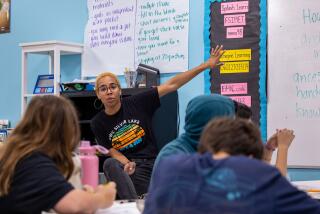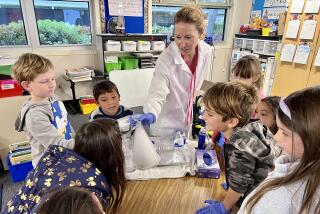A Saturday Class Where the Chemistry Clicks : Special Science Program at UCI Makes Learning Fun for Elementary Students
- Share via
Take a handful of marshmallows, a few toothpicks, a bowl of water, a dollop of cooking oil, a squirt of dish soap, a splash of liquid nitrogen and a nugget of potassium.
Add about 125 fourth, fifth and sixth graders, an enthusiastic chemistry professor and a Saturday morning.
The formula may not be scientific, but the result has everything to do with science. Marshmallows and toothpicks are transformed into models of water and ammonia molecules.
Water and oil don’t mix, everyone knows, but add the peculiar molecular structure of soap, and soon all the water, oil and soap molecules are holding hands. Pour liquid nitrogen on the carpet, and it disappears into a vapor. Drop a piece of potassium in a bowl of water, and a flame skips across the surface.
It was chemistry made fun over the weekend during the third session of “Saturdays for Science,” an educational program by UC Irvine that tempts fourth-, fifth- and sixth-grade students away from their weekend games and into a college classroom for entertaining lectures and experiments.
The beginning series, called “Molecules Around Us,” teaches the youngsters the basics of chemistry that they probably are not learning--or enjoying--in their elementary school classrooms, said Mare Taagepera, a UCI chemistry professor who organized the series, which is taught by her and three colleagues.
“It’s not that hard,” Quentin Clark, 9, of Irvine, a fourth-grade student at Culverdale Elementary School, said as he displayed a marshmallow-and-toothpick molecular model. “I like the experiments.”
Asked how he liked sitting inside for a science lesson when others his age are playing outdoors, John Whiting, 8, of Irvine replied: “I’d rather be here. It’s fun.”
Later, students watched wide-eyed as Taagepera combined two pre-mixed chemical solutions and--before their eyes--created strings of nylon when the chemicals reacted. The youngsters clamored to be chosen to spin the nylon from the film forming in the beaker of chemicals.
“I love it,” said Steven Miller, 9, of Mission Viejo, a fourth-grade student at O’Neill Elementary School, who plans to be a scientist when he growns up. “It was weird,” he said of the nylon experiment. “It came up in separate strings of thread.”
A total of 250 students signed up for the four-week series, with each session offered twice on Saturday mornings. Cost of the series is $15, and parents must deliver the children to the university classroom and pick up them up later.
Lessons Are Supplementary
The goal of the Saturday series is not to recruit new scientists but to supplement science lessons, which are sorely lacking in elementary school, Taagepera said. Elementary school instructors are not teaching science well because many of them were never excited by the subject when they were students, she said.
George Miller, another UCI chemistry professor teaching the series, said elementary school teachers spend as little as seven minutes a day on science in their classrooms.
“Many aren’t teaching it because they don’t know about it,” he said. “And this is hard, hard to teach.”
Taagepera said she realizes that the youngsters are not going to remember everything in the course. “But if they understand 50%, we’re doing well,” and their exposure to the information now will help them grasp the complex subject more easily in the future, she said.
Molecular properties became simple when Taagepera demonstrated them with mostly household items. She poured oil on top of water and, despite her attempts to mix the two liquids, they refused to intermingle. Why? Because water molecules are “polar,” having negative and positive electrical charges, she said, while oil molecules are “non-polar,” having no charges. The water and oil molecules will not hang together because they are not alike, she explained.
But add a squirt of soap--with a molecular makeup that is polar on one end and non-polar on the other--and suddenly the liquids mix because “soap holds hands with the water molecule and the oil molecule,” Taagepera said. Suddenly, the students understood why their parents nag them to wash their greasy hands with soap and water.
Many Parents Attend
Potassium and water also do not get along, but potassium does more than not mix--it produces an explosion from the chemical reaction, Taagepera said, dropping a piece of potassium into a bowl of water. Indeed, a tiny flame skimmed across the water, with the potassium molecule “running after the water molecule and ripping it apart,” she said.
It has been interesting to see many of the students’ parents developing new interest in science along with their children, Taagepera said. The parents stay for the lessons and ask questions afterward, she said.
Many parents, elementary and even high school teachers are scared of science, and they pass their attitudes on to the students, Taagepera and Miller said. Taagepera also teaches science to elementary school teachers, and it takes them a few lessons before they overcome their fears, she said.
“There’s a lot of panic out there that shouldn’t be out there,” Taagepera said.
It is important for all students--not just science majors--to grasp the basic lessons of science in order to understand public problems, such as pollution and waste management, Miller and Taagepera said. Solutions must be found to the problems, and if the general public can grasp the basics, it will be more understanding of the cure, they said.
“We need scientifically literate citizens,” Miller said. “There are solutions, and they’re expensive, and if science were understood more, they (the public) would be more willing to pay (for the solutions),” Miller said.
Change in Attitude
By showing young students that science is fun, some of those attitudes can be turned around, Taagepera and Miller said.
Yes, they know that kids usually are out playing soccer or baseball on Saturday mornings. But it should not be considered odd that the students would rather sit inside a UCI classroom on a weekend and learn about science, even though they have science lessons in school Monday through Friday, they said.
“We’re competing with soccer,” Miller acknowledged. “But you can also ask why are they doing that (playing soccer) on a Saturday? They get P. E. in school, too.”
More to Read
Sign up for Essential California
The most important California stories and recommendations in your inbox every morning.
You may occasionally receive promotional content from the Los Angeles Times.










